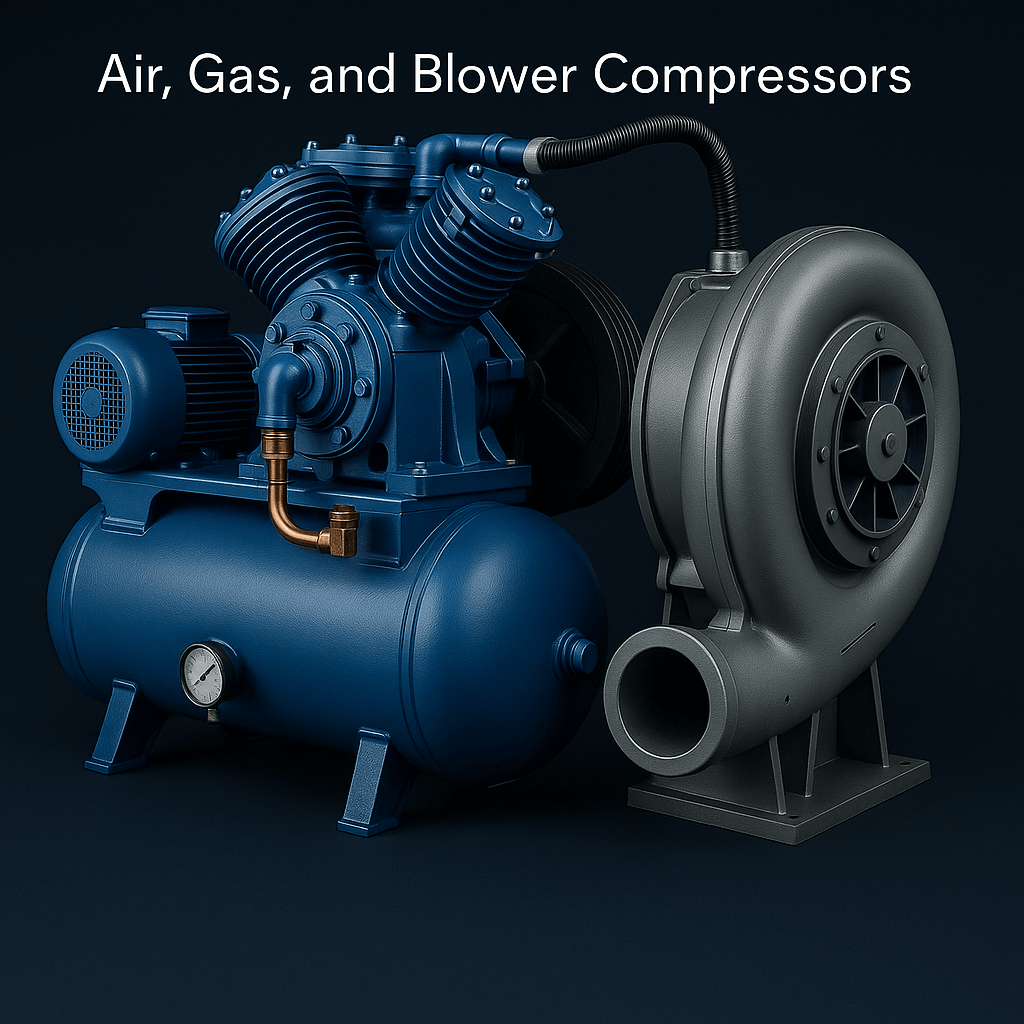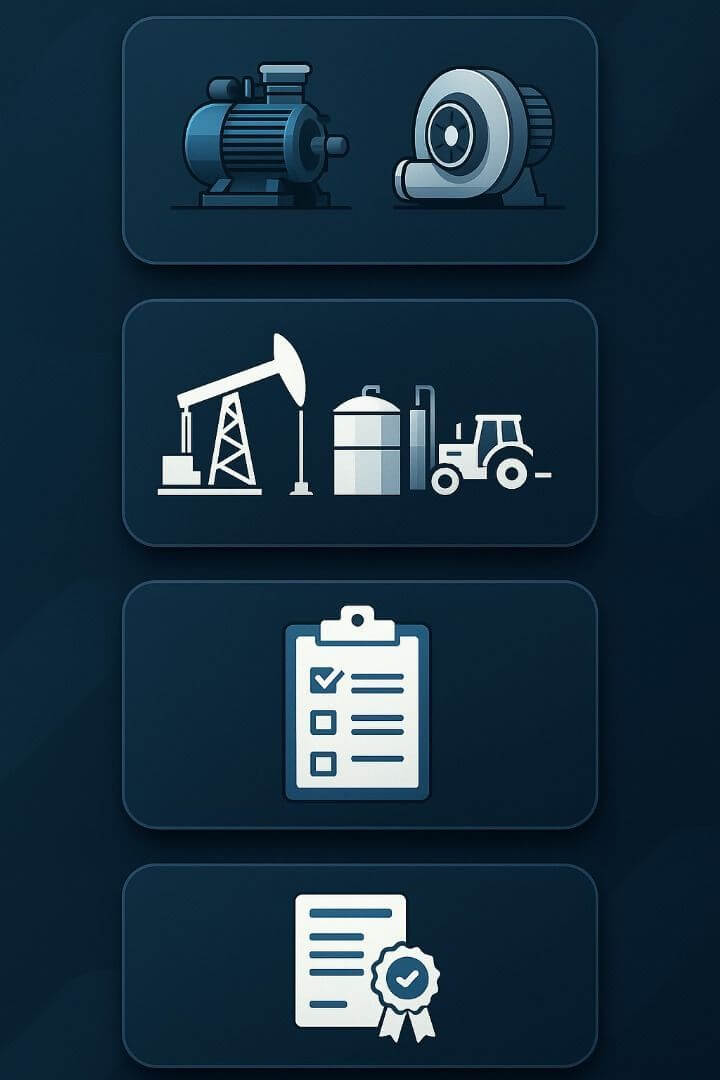Customs Clearance of Air Compressors, Gas Compressors & Blowers in Iran (HS Code + Documents & Permits)
Compressors and blowers are essential and critical equipment across many industries. Air and gas compressors are devices used to compress gases and air. This compression process increases pressure, thereby supplying the energy required to power various industrial activities. These machines are used in oil & gas, petrochemicals, automotive, pharmaceuticals, food industries, agriculture, and many other fields.
Blowers (fans) are devices that generate airflow or gas flow for ventilation, cooling, heating, and drying processes. By creating air movement, they enable the transfer of heat, moisture, and other environmental properties.

To estimate the time and cost of compressor & blower clearance, contact the Saba Tarkhis experts.
Instant free consultation1) Detailed Description: Air Compressors, Gas Compressors & Blowers
A compressor intakes and compresses a compressible fluid (air or gas), raises its pressure, and stores pressure potential energy. This energy is then used in diverse applications such as powering pneumatic tools, gas transfer in pipelines, refrigeration & HVAC, refinery/petrochemical unit operations, and even packaging and material handling. Compressors by mechanism are grouped into dynamic (centrifugal/axial) and positive displacement (reciprocating/screw/scroll/roots). Each family has its own operating range, working pressure, flow, efficiency, noise, maintenance requirements, and installation sensitivities. Proper type selection depends on factors like working fluid (dry/wet, corrosive/non-corrosive), target pressure/flow, duty cycle, required air quality (dry, oil-free, ISO class), ambient conditions, and life-cycle cost (CAPEX/OPEX).
Blowers (fans) create and maintain air/gas flow at comparatively lower pressure differences and are essential in industrial ventilation, pollution control, drying, equipment cooling, furnaces, and HVAC processes. Proper selection of fan performance curves balances flow, head, efficiency, and noise. For both categories, build quality, electrical/mechanical safety standards, and compliance with environmental/energy regulations are crucial.
Applications of Air/Gas Compressors and Blowers Across Industries
Compressors and blowers are vital assets that drive efficiency and reliable operation across many industrial processes. By compressing gases/air and generating strong flow, they enable complex operations. Below are key industry applications:1. Oil & Gas
Natural gas compressors are fundamental in production and transmission. They compress and transport gas from fields to refineries, distribution networks, and end users. They are also used for boosting associated gas pressure, gas separation and treatment, and gas injection into reservoirs for enhanced oil recovery. In refineries, gas compressors support separation and processing of various gases such as propane, butane, and ethylene.
2. Automotive
Air compressors supply high-pressure compressed air and are key in automotive manufacturing lines. They power paint shops for uniform spray quality and support pneumatic systems such as air brakes, air suspension, assembly, and testing tools, improving precision and quality of parts and final assembly.
3. Pharmaceuticals & Healthcare
Air/gas compressors provide clean compressed air for drug manufacturing, material conveying, packaging, and clean-room controls. Blowers are used for HVAC, temperature, and humidity control. Proper filtration and drying are essential to ensure compressed air quality, especially wherever air may contact pharmaceutical products.
4. Agriculture
Compressors support pressurized irrigation systems (drip/sprinkler), ensuring uniform distribution of water and liquid fertilizers. They also serve agricultural machinery and conveying. Blowers ventilate greenhouses and storage facilities, maintaining temperature and humidity to preserve product quality.
5. Food Industry
In food processing, air compressors provide high-quality compressed air for production and packaging—filling, packaging lines, air conveyors, drying, and transfer. Air must be contaminant-free to ensure food safety. Blowers handle ventilation and climate control in plants and cold storage.
6. HVAC & Industrial Cooling
Blowers and compressors are core to HVAC systems. Compressors pressurize refrigerants to provide cooling/heating in industrial and commercial environments. Blowers circulate air, ensuring proper conditions. They are also used in refrigerators, chillers, and other cooling systems.
2) Types & Applications
Common Compressor Types
- Positive displacement: reciprocating (oil-free/oil-injected), screw, scroll, diaphragm.
- Dynamic: centrifugal, axial.
- Applications: pneumatic tools, gas transport, refrigeration & HVAC, petrochemical processes, packaging.
Blower/Fan Types
- Axial, centrifugal, radial, cross-flow; driven by electric motors or turbines.
- Applications: industrial ventilation, filtration, drying, production line cooling.
3) Key Tips for Clearing Compressors & Blowers
Given their importance, customs clearance requires careful attention to technical details and relevant regulations. Key points include:1. Technical Documents & Dossiers
Provide accurate, validated technical documents: spec sheets, catalogs/manuals (translated into the destination language if required). They should state application, power, working pressure, gas/air type, and special capabilities.
2. Certificate of Origin
The CO is essential, indicating the manufacturing/exporting country and compliance with import standards. Typically issued by the origin country’s chamber of commerce and authenticated by competent authorities.
3. National & International Standards
Some compressors/blowers must carry quality and conformity certifications such as safety (ISO/CE/UL), quality (ISO 9001), and environmental (ISO 14001). Non-compliance may cause clearance rejection and return to origin.
4. Special Permits
For certain uses (e.g., food/pharma), health and standards permits may be required from authorities such as the Ministry of Health or the National Standards Organization of Iran, verifying sanitary and safety compliance.
4) Customs Tariff / HS Codes for Compressors & Blowers
The Harmonized System (HS), developed by the World Customs Organization, classifies goods internationally. Compressors and blowers fall under Chapter 84. Common HS Codes include:
| Item | Short Description | HS Code |
|---|---|---|
| Air compressors | Industrial compressed air | 841480 |
| Gas compressors | Process gas compression | 841430 |
| Blowers/Fans | Air/gas flow generation | 841459 |
Each code represents a specific machine type; depending on technical specs and usage, more granular subheadings may apply. Confirm the exact HS Code before starting clearance to avoid issues.
5) Special Conditions for Import & Export
Import and export of compressors and blowers are subject to national and international regulations. Key points:Imports: China, Germany, Italy, and Japan are major exporters to Iran. Imports must comply with national standards and Iranian import rules.
Exports: In recent years, Iran has exported some domestically produced compressors and blowers to neighboring countries such as Iraq and Afghanistan. Exports must comply with international standards and destination-country regulations.
6) Iran Market: Supply, Demand & Sourcing
- External sourcing from China, Germany, Italy, and Japan; imports driven by oil & gas, automotive, pharma, and food sectors.
- Domestic manufacturers exist for some segments (pneumatic tools/industrial blowers); specialized needs are covered by imports.
- Standards, energy efficiency, and compressed air quality (ISO 8573) matter significantly in sensitive industries.
7) Trade Volume
Iran’s imports of air and gas compressors are relatively high due to broad industrial demand. These include compressors for industrial and general uses, sourced from advanced industrial countries. Conversely, Iran has been able to supply part of neighboring markets’ demand for compressors and blowers.
8) Global Market: Major Exporters & Importers
Top exporters: China, Germany, Italy, Japan, and the USA are leading producers and exporters of compressors and blowers.
Top importers: Many Asian and European countries, driven by widespread industrial usage, are major importers.
9) Documents Required for Clearance
- Commercial Invoice, Packing List, Bill of Lading/AWB, and Cargo Insurance.
- Catalog/Manual & technical specs (power, working pressure, flow, air quality class, gas type).
- Valid Certificate of Origin (CO) authenticated by the origin country’s chamber.
- Standards/safety certificates (ISO/CE/UL); for sensitive industries, health permits from competent authorities as required.
Key Tips for Successful Compressor/Blower Clearance
- Confirm the HS Code before final purchase; technical specs can change the tariff line.
- For food/pharma, document air quality class and oil-free requirements.
- Include electrical/safety standards (CE/UL) and energy efficiency details.
- Provide up-to-date catalogs, manuals, and test reports with names matching the goods.

FAQs
What are common HS Codes for compressors and blowers?
Air compressors: 841480; gas compressors: 841430; blowers/fans: 841459. Exact subheading depends on technical specs.
Which documents are needed for clearance?
Invoice, packing list, B/L or AWB, insurance, certificate of origin, catalogs/manuals, technical specs, and standards certificates (plus health permits where applicable).
How to speed up compressor clearance?
Pre-confirm HS Code, pre-check documents, register in the customs system, obtain permits, perform formalities and payments, schedule delivery and transport.
Are there special requirements for food/pharma?
Yes. Provide health certifications, compressed air quality class, proper filters/dryers, and compliance with national/international standards.
Saba Brokerage’s Specialized Services for Compressor & Blower Clearance
With many years of experience clearing industrial equipment—especially compressors and blowers—we provide comprehensive, specialized services:
Expert consultation: Our experienced team supports you from initial advice to practical solutions, helping you choose the best route for clearance.
Document preparation & review: We thoroughly review technical and required documents to ensure smooth, fast clearance—covering full standards compliance and preventing delays.
Liaison with authorities: We obtain and provide all necessary permits and certificates from relevant organizations, ensuring full compliance with national and international standards.
Customs formalities: Leveraging deep knowledge of customs rules, we complete your clearance quickly and accurately.
Logistics: After clearance, we arrange safe, timely transport to your final destination.
Through these specialized services, we streamline your import/export process professionally and efficiently so you can fully benefit from industrial trade.
.png)
